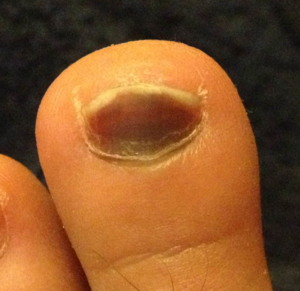Nail bed laceration
| Nail bed laceration | |
|---|---|
| Other names: Nail bed injury | |
 | |
| A nail bed laceration may present with blood under the nail | |
| Specialty | Emergency medicine |
| Symptoms | Pain, blood under the nail[1][2] |
| Complications | Tuft fracture, Seymour fracture[3][4] |
| Causes | Cut, crush injury[3] |
| Diagnostic method | Based on symptoms and examination, X-rayss[1][5] |
| Treatment | Drainage of blood from the nail, sutures, glue[6][1] |
| Prognosis | Improves over 2 to 4 months[7] |
| Frequency | Relatively common[1] |
A nail bed laceration is a type of injury to the nail bed.[1] Symptoms may include pain and blood under the nail.[2][1] It may be associated with a tuft fracture or Seymour fracture.[3][4]
It may occur due to a cut or crush injury, such as by a door or hammer.[3][8] Types include simple, stellate, and crush.[9][2] Diagnosis is based on symptoms and examination.[1] X-rays are done to look for underlying bone fractures.[5]
Small injuries without disruption to the nail generally do not require specific treatment; though, blood under the nail may be drained.[6][10] Otherwise management may involve closing with sutures.[3] It the injury is a simple cut, the nail may be left on and sutured through.[11] In a crush injury the nail may be removed and the nail bed closed with absorbable sutures.[3] There is no evidence that placing material to hold open the nail fold following repair is needed.[12] A ring block and finger tourniquet may help with management.[1]
Nail bed lacerations are relatively common.[1] Young males are most often affected.[1] While the best way to manage a nail bed lacerations has been poorly studied, removal of the nail and suturing is more expensive.[13] For a fingernail to grow out requires about 2 months while for a toenail 4 months is needed.[7]
Management
Repair may be carried out after a ring block using lidocaine or lidocaine/epinephrine.[1] While the best way to manage nail bed lacerations has been poorly studied, removal of the nail and suturing is more expensive.[13] If the nail is removed, there is no evidence that placing material to hold open the nail fold following repair is needed.[12][14]
Preventative antibiotics are generally not required, even if an underlying fracture is present; exceptions to this are animal bites.[2]
Glue, specifically 2-octyl cyanoacrylate, is another option to sutures.[1]
References
- ↑ 1.00 1.01 1.02 1.03 1.04 1.05 1.06 1.07 1.08 1.09 1.10 1.11 Mattison, Gennaya L.; Leis, Amber R. (July 2019). "Nail Bed Injury". Operative Plastic Surgery: 911–930. doi:10.1093/med/9780190499075.003.0090.
- ↑ 2.0 2.1 2.2 2.3 "Fingertip and nail injuries – Emergency Department". Retrieved 24 February 2024.
- ↑ 3.0 3.1 3.2 3.3 3.4 3.5 Wang, QC; Johnson, BA (15 May 2001). "Fingertip injuries". American family physician. 63 (10): 1961–6. PMID 11388710.
- ↑ 4.0 4.1 S, A. "Seymour fracture | Radiology Reference Article | Radiopaedia.org". Radiopaedia. Archived from the original on 27 September 2023. Retrieved 24 February 2024.
- ↑ 5.0 5.1 "Nail Bed Laceration". fpnotebook.com. Archived from the original on 28 November 2022. Retrieved 24 February 2024.
- ↑ 6.0 6.1 "Fingertip Fractures - Injuries; Poisoning". Merck Manuals Professional Edition. Archived from the original on 23 March 2023. Retrieved 24 February 2024.
- ↑ 7.0 7.1 "Nail Trauma". Harvard Health. 19 December 2018. Archived from the original on 24 February 2024. Retrieved 4 March 2024.
- ↑ Bharathi, RR; Bajantri, B (May 2011). "Nail bed injuries and deformities of nail". Indian journal of plastic surgery : official publication of the Association of Plastic Surgeons of India. 44 (2): 197–202. doi:10.4103/0970-0358.85340. PMID 22022029.
- ↑ Venkatesh, A; Khajuria, A; Greig, A (January 2020). "Management of Pediatric Distal Fingertip Injuries: A Systematic Literature Review". Plastic and reconstructive surgery. Global open. 8 (1): e2595. doi:10.1097/GOX.0000000000002595. PMID 32095403.
- ↑ Chen, F; Kalainov, DM (March 2017). "Phalanx fractures and dislocations in athletes". Current reviews in musculoskeletal medicine. 10 (1): 10–16. doi:10.1007/s12178-017-9378-7. PMID 28185123.
- ↑ MD, Michelle Lin (6 January 2010). "Trick of the Trade: Finger nailbed laceration repair". ALiEM. Archived from the original on 2 October 2023. Retrieved 23 February 2024.
- ↑ 12.0 12.1 Hawken, JB; Giladi, AM (February 2021). "Primary Management of Nail Bed and Fingertip Injuries in the Emergency Department". Hand clinics. 37 (1): 1–10. doi:10.1016/j.hcl.2020.09.001. PMID 33198909.
- ↑ 13.0 13.1 Fieg, Edward L. (15 May 2002). "Management of Nail Bed Lacerations". American Family Physician. 65 (10): 1997a–1998. Archived from the original on 28 June 2022. Retrieved 24 February 2024.
- ↑ Jain, A; Greig, AVH; Jones, A; Cooper, C; Davies, L; Greshon, A; Fletcher, H; Sierakowski, A; Dritsaki, M; Nguyen, TTA; Png, ME; Stokes, JR; Dakin, H; Cook, JA; Beard, DJ; Gardiner, MD; NINJA, Collaborative (30 March 2023). "Effectiveness of nail bed repair in children with or without replacing the fingernail: NINJA multicentre randomized clinical trial". The British journal of surgery. 110 (4): 432–438. doi:10.1093/bjs/znad031. PMID 36946338.